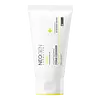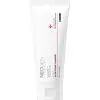What's inside
What's inside
 Key Ingredients
Key Ingredients

 Benefits
Benefits

 Concerns
Concerns

 Ingredients Side-by-side
Ingredients Side-by-side

Water
Skin ConditioningGlycerin
HumectantPalmitic Acid
EmollientMyristic Acid
CleansingStearic Acid
CleansingPropylene Glycol
HumectantPotassium Hydroxide
BufferingLauric Acid
CleansingPEG-75
HumectantCocamidopropyl Betaine
CleansingGlyceryl Stearate
EmollientPEG-100 Stearate
Beeswax
Emulsion StabilisingPanthenol
Skin ConditioningSalicylic Acid
MaskingPEG-14m
Emulsion StabilisingCitrus Paradisi Fruit Extract
Skin ConditioningCamellia Sinensis Leaf Extract
AntimicrobialCentella Asiatica Extract
CleansingLaminaria Japonica Extract
Skin ProtectingHamamelis Virginiana Extract
AntiseborrhoeicGuaiazulene
AntimicrobialGlycyrrhiza Uralensis Extract
EmollientMelaleuca Alternifolia Leaf Oil
AntioxidantAllantoin
Skin ConditioningSodium Chloride
MaskingDisodium EDTA
Butylene Glycol
Humectant1,2-Hexanediol
Skin ConditioningPhenoxyethanol
PreservativeWater, Glycerin, Palmitic Acid, Myristic Acid, Stearic Acid, Propylene Glycol, Potassium Hydroxide, Lauric Acid, PEG-75, Cocamidopropyl Betaine, Glyceryl Stearate, PEG-100 Stearate, Beeswax, Panthenol, Salicylic Acid, PEG-14m, Citrus Paradisi Fruit Extract, Camellia Sinensis Leaf Extract, Centella Asiatica Extract, Laminaria Japonica Extract, Hamamelis Virginiana Extract, Guaiazulene, Glycyrrhiza Uralensis Extract, Melaleuca Alternifolia Leaf Oil, Allantoin, Sodium Chloride, Disodium EDTA, Butylene Glycol, 1,2-Hexanediol, Phenoxyethanol
Water
Skin ConditioningLauryl Hydroxysultaine
CleansingSodium Chloride
MaskingPotassium Cocoyl Glycinate
Acrylates Copolymer
Disodium Cocoamphodiacetate
CleansingSodium Methyl Cocoyl Taurate
CleansingPotassium Cocoate
EmulsifyingSalicylic Acid
MaskingSodium Benzoate
MaskingMelaleuca Alternifolia Leaf Oil
AntioxidantHexylene Glycol
EmulsifyingDisodium EDTA
Citric Acid
BufferingGuaiazulene
AntimicrobialGluconolactone
Skin ConditioningCalamine
AbsorbentPanthenol
Skin ConditioningCapryloyl Salicylic Acid
ExfoliatingGlycyrrhiza Glabra Root Extract
BleachingGlycolic Acid
BufferingButylene Glycol
Humectant1,2-Hexanediol
Skin ConditioningCamellia Sinensis Leaf Extract
AntimicrobialCentella Asiatica Extract
CleansingMadecassoside
AntioxidantMelaleuca Alternifolia Leaf Extract
PerfumingWater, Lauryl Hydroxysultaine, Sodium Chloride, Potassium Cocoyl Glycinate, Acrylates Copolymer, Disodium Cocoamphodiacetate, Sodium Methyl Cocoyl Taurate, Potassium Cocoate, Salicylic Acid, Sodium Benzoate, Melaleuca Alternifolia Leaf Oil, Hexylene Glycol, Disodium EDTA, Citric Acid, Guaiazulene, Gluconolactone, Calamine, Panthenol, Capryloyl Salicylic Acid, Glycyrrhiza Glabra Root Extract, Glycolic Acid, Butylene Glycol, 1,2-Hexanediol, Camellia Sinensis Leaf Extract, Centella Asiatica Extract, Madecassoside, Melaleuca Alternifolia Leaf Extract
Ingredients Explained
These ingredients are found in both products.
Ingredients higher up in an ingredient list are typically present in a larger amount.
1,2-Hexanediol is a synthetic liquid and another multi-functional powerhouse.
It is a:
- Humectant, drawing moisture into the skin
- Emollient, helping to soften skin
- Solvent, dispersing and stabilizing formulas
- Preservative booster, enhancing the antimicrobial activity of other preservatives
Butylene Glycol (or BG) is used within cosmetic products for a few different reasons:
Overall, Butylene Glycol is a safe and well-rounded ingredient that works well with other ingredients.
Though this ingredient works well with most skin types, some people with sensitive skin may experience a reaction such as allergic rashes, closed comedones, or itchiness.
Learn more about Butylene GlycolCamellia Sinensis Leaf Extract is derived from the leaves of the tea plant. Black tea, green tea, and oolong tea are all harvested from this plant.
This ingredient has many skin benefits:
This ingredient contains polyphenols, a strong antioxidant. Antioxidants help fight off molecules that damage skin cells.
On top of that, the antioxidants in green tea neutralize free-radicals from the sun. This gives the skin some extra UV protection, but should not replace sunscreen.
Many components of tea have anti-inflammatory properties.
Polyphenols and L-theanine help soothe the skin and reduce irritation. The caffeine in Camellia Sinensis Leaf Extract helps calm inflamed blood vessels.
Other compounds found in tea include: Vitamin Bs, linoleic acid, magnesium, calcium, iron, and zinc.
Research has shown both drinking Camellia Sinensis Leaf Tea and applying it to the skin can help boost skin elasticity and hydration. Studies also show using tea extract may reduce sebum, or oil, production.
Learn more about Camellia Sinensis Leaf ExtractCentella Asiatica Extract (Centella) is derived from an herb native to Southeast Asia. It is famous for its anti-inflammatory and soothing properties.
Centella is rich in antioxidants and amino acids, such as Madecassic Acid and Asiaticoside.
Studies show the compounds in centella help with:
The combination of all these properties makes centella effective at soothing, hydrating, and protecting the skin.
Other great components of centella include Vitamin A, vitamin C, several B vitamins, and Asiatic Acid.
Fun fact: Centella has been used as a medicine and in food for many centuries. As a medicine, it is used to treat burns, scratches, and wounds.
Learn more about Centella Asiatica ExtractDisodium EDTA plays a role in making products more stable by aiding other preservatives.
It is a chelating agent, meaning it neutralizes metal ions that may be found in a product.
Disodium EDTA is a salt of edetic acid and is found to be safe in cosmetic ingredients.
Learn more about Disodium EDTAGuaiazulene is a fragrance.
This tea tree oil comes from the leaves of the Tea Tree plant. Tea tree oil has antioxidant, anti-inflammatory, and antimicrobial properties.
According to the book Journal of Profiles of Drug Substances, tea tree helps in reducing acne-causing bacteria such as Propionibacterium acnes. This is due to the Terpinen components of tea tree oil.
Tea tree may cause sensitivity and irritation for some people. This oil naturally contains fragrance such as linalool and limonene.
However, research shows irritation usually occurs when using pure tea tree oil and not in cosmetic products.
Tea tree oil was found to help relieve the symptoms of psoriasis in one study.
Tea tree oil is toxic when ingested. Another study showed it to caused damage to the nervous system of dogs and cats when applied to their skin or given orally.
Learn more about Melaleuca Alternifolia Leaf OilPanthenol is a common ingredient that helps hydrate and soothe the skin. It is found naturally in our skin and hair.
There are two forms of panthenol: D and L.
D-panthenol is also known as dexpanthenol. Most cosmetics use dexpanthenol or a mixture of D and L-panthenol.
Panthenol is famous due to its ability to go deeper into the skin's layers. Using this ingredient has numerous pros (and no cons):
Like hyaluronic acid, panthenol is a humectant. Humectants are able to bind and hold large amounts of water to keep skin hydrated.
This ingredient works well for wound healing. It works by increasing tissue in the wound and helps close open wounds.
Once oxidized, panthenol converts to pantothenic acid. Panthothenic acid is found in all living cells.
This ingredient is also referred to as pro-vitamin B5.
Learn more about PanthenolSalicylic Acid (also known as beta hydroxy acid or BHA) is a well-known ingredient for treating skin that struggles with acne and clogged pores. It exfoliates both the skin's surface and deep within the pores to help clear out buildup, control oil, and reduce inflammation.
Unlike AHAs (alpha hydroxy acids), salicylic acid is oil-soluble. This allows it to penetrate into pores which makes it especially effective for treating blackheads and preventing future breakouts.
Salicylic acid is also known for its soothing properties. It has a similar structure to aspirin and can calm inflamed or irritated skin, making it a good option for acne-prone skin that is also sensitive.
Concentrations of 0.5-2% are recognized by the U.S. FDA as an over-the-counter topical acne product.
It can cause irritation and/or dryness if one's skin already has a compromised moisture barrier, so it's best to focus on repairing that before introducing this ingredient into your routine.
While salicylic acid does not increase sun sensitivity, it’s still important to wear sunscreen daily to protect your skin.
If you are looking for the ingredient called BHA or Butylated Hydroxyanisole, click here.
Learn more about Salicylic AcidChances are, you eat sodium chloride every day. Sodium Chloride is also known as table salt.
This ingredient has many purposes in skincare: thickener, emulsifier, and exfoliator.
You'll most likely find this ingredient in cleansers where it is used to create a gel-like texture. As an emulsifier, it also prevents ingredients from separating.
There is much debate on whether this ingredient is comedogenic. The short answer - comedogenic ratings don't tell the whole story. Learn more about comegodenic ratings here.
The concensus about this ingredient causing acne seems to be divided. Research is needed to understand if this ingredient does cause acne.
Scrubs may use salt as the primary exfoliating ingredient.
Learn more about Sodium ChlorideWater. It's the most common cosmetic ingredient of all. You'll usually see it at the top of ingredient lists, meaning that it makes up the largest part of the product.
So why is it so popular? Water most often acts as a solvent - this means that it helps dissolve other ingredients into the formulation.
You'll also recognize water as that liquid we all need to stay alive. If you see this, drink a glass of water. Stay hydrated!
Learn more about Water